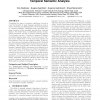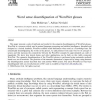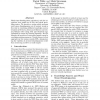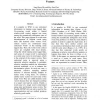74 search results - page 2 / 15 » Using Semantic Relatedness and Word Sense Disambiguation for... |
IJCAI
2003
13 years 7 months ago
2003
This paper presents a new measure of semantic relatedness between concepts that is based on the number of shared words (overlaps) in their definitions (glosses). This measure is ...
WWW
2011
ACM
13 years 21 days ago
2011
ACM
Computing the degree of semantic relatedness of words is a key functionality of many language applications such as search, clustering, and disambiguation. Previous approaches to c...
CSL
2004
Springer
13 years 5 months ago
2004
Springer
This paper presents a suite of methods and results for the semantic disambiguation of WordNet glosses. WordNet is a resource widely used in natural language processing and artific...
ACL
1998
13 years 7 months ago
1998
Word sense disambiguation algorithms, with few exceptions, have made use of only one lexical knowledge source. We describe a system which t)erforms word sense disambiguation on al...
COLING
2002
13 years 5 months ago
2002
It is popular in WSD to use contextual information in training sense tagged data. Co-occurring words within a limited window-sized context support one sense among the semantically...




